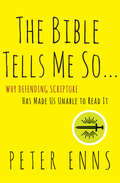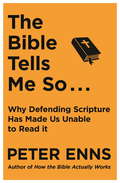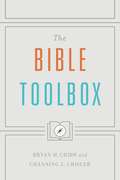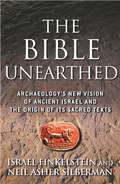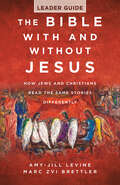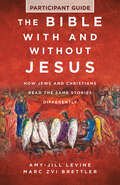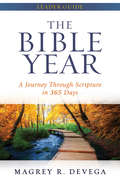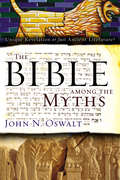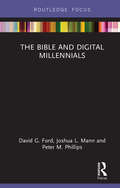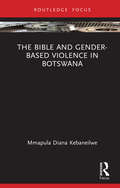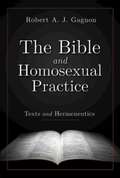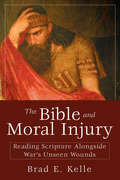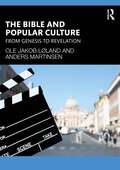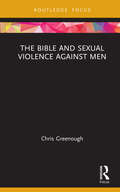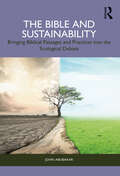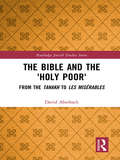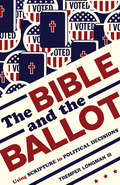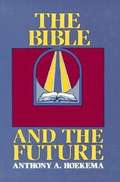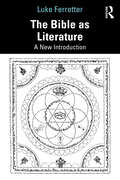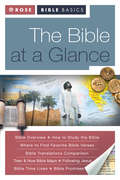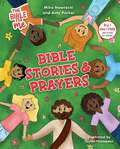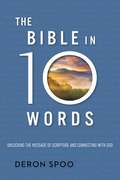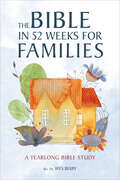- Table View
- List View
The Bible Tells Me So: Why Defending Scripture Has Made Us Unable to Read It
by Peter EnnsThe controversial Bible scholar and author of The Evolution of Adam recounts his transformative spiritual journey in which he discovered a new, more honest way to love and appreciate God's Word.Trained as an evangelical Bible scholar, Peter Enns loved the Scriptures and shared his devotion, teaching at Westminster Theological Seminary. But the further he studied the Bible, the more he found himself confronted by questions that could neither be answered within the rigid framework of his religious instruction or accepted among the conservative evangelical community.Rejecting the increasingly complicated intellectual games used by conservative Christians to "protect" the Bible, Enns was conflicted. Is this what God really requires? How could God's plan for divine inspiration mean ignoring what is really written in the Bible? These questions eventually cost Enns his job--but they also opened a new spiritual path for him to follow.The Bible Tells Me So chronicles Enns's spiritual odyssey, how he came to see beyond restrictive doctrine and learned to embrace God's Word as it is actually written. As he explores questions progressive evangelical readers of Scripture commonly face yet fear voicing, Enns reveals that they are the very questions that God wants us to consider--the essence of our spiritual study.
The Bible Tells Me So: Why defending Scripture has made us unable to read it
by Peter EnnsPeter Enns recounts his transformative spiritual journey in which he discovered a new, more honest way to love and appreciate God's Word.Trained as an evangelical Bible scholar, Peter Enns loved the Scriptures and shared his devotion, teaching at Westminster Theological Seminary. But the further he studied the Bible, the more he found himself confronted by questions that could neither be answered within the rigid framework of his religious instruction or accepted among the conservative evangelical community.Rejecting the increasingly complicated intellectual games used by conservative Christians to 'protect' the Bible, Enns was conflicted. Is this what God really requires? How could God's plan for divine inspiration mean ignoring what is really written in the Bible? These questions eventually cost Enns his job - but they also opened a new spiritual path for him to follow.The Bible Tells Me So chronicles Enns' spiritual odyssey, how he came to see beyond restrictive doctrine and learned to embrace God's Word as it is actually written. As he explores questions progressive evangelical readers of Scripture commonly face yet fear voicing, Enns reveals that they are the very questions that God wants us to consider - the essence of our spiritual study.
The Bible Toolbox
by Bryan Cribb Channing L. CrislerIn Bible Toolbox, authors Bryan H. Cribb and Channing L. Crisler equip students with the proper tools to engage and interpret the Scriptures for themselves. This book introduces readers to the Bible by giving attention to each major section of Scripture. It also serves as a hermeneutical guide, teaching students how to use the tools described in the text to actively engage the Bible. Readers of Bible Toolbox will gain a deeper Biblical knowledge as they study this book, and will be able to use these tools as they continue to study the Bible for years to come.
The Bible Unearthed: Archaeology's New Vision of Ancient Israel and the Origin of Sacred Texts
by Israel Finkelstein Neil Asher SilbermanIn this groundbreaking work that sets apart fact and legend, authors Finkelstein and Silberman use significant archeological discoveries to provide historical information about biblical Israel and its neighbors.In this iconoclastic and provocative work, leading scholars Israel Finkelstein and Neil Asher Silberman draw on recent archaeological research to present a dramatically revised portrait of ancient Israel and its neighbors. They argue that crucial evidence (or a telling lack of evidence) at digs in Israel, Egypt, Jordan, and Lebanon suggests that many of the most famous stories in the Bible—the wanderings of the patriarchs, the Exodus from Egypt, Joshua’s conquest of Canaan, and David and Solomon’s vast empire—reflect the world of the later authors rather than actual historical facts. Challenging the fundamentalist readings of the scriptures and marshaling the latest archaeological evidence to support its new vision of ancient Israel, The Bible Unearthed offers a fascinating and controversial perspective on when and why the Bible was written and why it possesses such great spiritual and emotional power today.
The Bible With and Without Jesus - Leader Guide: How Jews and Christians Read the Same Stories Differently
by Amy-Jill Levine Marc Zvi BrettlerScholars show how Jews and Christians read the same texts differently.The leader guide contains discussion questions and session plans for the study. It includes opening and closing prayers, optional activities, and weekly session goals. This leader guide, participant guide, and DVD are everything needed for an engaging study for your small group.In this Bible study based on their book, The Bible With and Without Jesus, esteemed Bible scholars and teachers Amy-Jill Levine and Marc Zvi Brettler take readers on a guided tour of the most popular Hebrew Bible passages quoted in the New Testament to show what the texts meant in their original contexts and then how Jews and Christians, over time, understood those same texts. Passages include the creation of the world, the role of Adam and Eve, the Suffering Servant of Isaiah, the book of Jonah, and Psalm 22, whose words, “My God, my God, why have you forsaken me,” Jesus quotes as he dies on the cross.Comparing various interpretations – historical, literary, and theological - of each ancient text, Levine and Brettler offer deeper understandings of the original narratives and their many afterlives. They show how the text speaks to different generations under changed circumstances, illuminating the Bible’s ongoing significance. By understanding the depth and variety by which these passages have been, and can be, understood, The Bible With and Without Jesus does more than enhance our religious understandings; it helps us to see the Bible as a source of inspiration for any and all readers.
The Bible With and Without Jesus - Participant Guide: How Jews and Christians Read the Same Stories Differently
by Amy-Jill Levine Marc Zvi BrettlerScholars show how Jews and Christians read the same texts differently.This participant guide introduces the main text and further Scripture commentary and reflection questions. It, along with the leader guide and DVD, is everything needed for an engaging study for your small group.In this Bible study based on their book, The Bible With and Without Jesus, esteemed Bible scholars and teachers Amy-Jill Levine and Marc Zvi Brettler take readers on a guided tour of the most popular Hebrew Bible passages quoted in the New Testament to show what the texts meant in their original contexts and then how Jews and Christians, over time, understood those same texts. Passages include the creation of the world, the role of Adam and Eve, the Suffering Servant of Isaiah, the book of Jonah, and Psalm 22, whose words, “My God, my God, why have you forsaken me,” Jesus quotes as he dies on the cross.Comparing various interpretations – historical, literary, and theological - of each ancient text, Levine and Brettler offer deeper understandings of the original narratives and their many afterlives. They show how the text speaks to different generations under changed circumstances, illuminating the Bible’s ongoing significance. By understanding the depth and variety by which these passages have been, and can be, understood, The Bible With and Without Jesus does more than enhance our religious understandings; it helps us to see the Bible as a source of inspiration for any and all readers.
The Bible Year Leader Guide: A Journey Through Scripture in 365 Days
by Magrey deVegaThe Bible. 365 days. You. Yes, you! Not the type to sit down and read the entire Bible? Yes, the goal is to read the whole Bible in a year, but think about it in terms of smaller, daily goals. Think about a commitment to read a short selection from the Bible plus a concise devotional every day. You can do that – especially since The Bible Year has it all mapped out for you day by day. Plus, you’ll also get summaries of key themes and ideas to help you better digest and understand your readings. So you’re not just reading verse after verse, you’re enriching your spiritual life, developing a deeper faith and forming a closer connection to God and to each other. The Bible Year is also a wonderful way for small groups or even individuals to grow closer to God, while providing a common thread that will promote new and deeper friendships among members. The Leader Guide contains 52 weeks of small group sessions based on the readings. Each session follows a concise, simple, and consistent lesson plan with discussion questions on the scriptures and instructions for using the videos if desired. Additional resources sold separately include a Devotional for every-day use and a Pastor's Guide for a church-wide emphasis.Daily Bible goals start here! Praise for The Bible Year When it comes to read-through-the-Bible-in-a-year programs, The Bible Year is a game changer. Packed with devotionals, discussion guides, and resources for pastors, this beautifully written book makes journeying through Scripture less daunting and more rewarding. It’s the perfect companion for those who wish to read through the Bible for the first time or those seek to go deeper in their study of Scripture together with others. – Ryan P. Bonfiglio, Director of the Candler Foundry and Assistant Professor of Old Testament, Candler Theological Seminary With a pastor’s devotion to God and the people he serves, deVega has structured a truly helpful guide for reading the Bible in the span of a year. The thoughtful format is well designed to encourage steady progress in reading, and provoke thoughtful reflection. Brief section summaries allow the reader to stay on top of the larger story line, and thoughtful questions and blank spaces support a meditative encounter. This book is a welcome gift for anyone who wants to grow in faithfulness and devotion. – Melody D. Knowles, Vice President of Academic Affairs and Associate Professor of Old Testament, Virginia Theological Seminary
The Bible among the Myths: Unique Revelation or Just Ancient Literature?
by John N. OswaltSixty years ago, most biblical scholars maintained that Israel’s religion was unique—that it stood in marked contrast to the faiths of its ancient Near Eastern neighbors. Nowadays, it is widely argued that Israel’s religion mirrors that of other West Semitic societies. What accounts for this radical change, and what are its implications for our understanding of the Old Testament? Dr. John N. Oswalt says the root of this new attitude lies in Western society’s hostility to the idea of revelation, which presupposes a reality that transcends the world of the senses, asserting the existence of a realm humans cannot control. While not advocating a “the Bible says it, and I believe it, and that settles it” point of view, Oswalt asserts convincingly that while other ancient literatures all see reality in essentially the same terms, the Bible differs radically on all the main points. The Bible Among the Myths supplies a necessary corrective to those who reject the Old Testament’s testimony about a transcendent God who breaks into time and space and reveals himself in and through human activity.
The Bible and Digital Millennials (Routledge Focus on Religion)
by David G. Ford Joshua L. Mann Peter M. PhillipsThe Bible and Digital Millennials explores the place of the Bible in the lives of 18 to 35 year-olds who have been born into the digital age. As the use of digital media becomes increasingly pervasive, it should follow that it will have a significant effect on people’s engagement with religion and the sacred texts associated with it. Drawing on contemporary in-depth surveys, this study unpacks digital millennials’ stance towards, use of and engagement with the Bible in both offline and online settings. The book features results from a nationally representative survey of 2,000 young British people specifically commissioned for this project. The data is also compared with the findings of others, including a poll of 850 British Bible-centric Christians and recent Bible engagement surveys from the USA. This book investigates the relevance of the Bible to the lives of those who have grown up in the digital age. It will, therefore, offer fresh insight to any scholar of biblical studies, religion and digital media, and religious studies.
The Bible and Gender-based Violence in Botswana (ISSN)
by Mmapula Diana KebaneilweThe Bible and Gender-based Violence in Botswana foregrounds the rampancy of gender-based violence against women and girls in biblical texts and how it resonates with gender-based violence (GBV) in the author’s contemporary context of Botswana.The volume reads selected texts from the Bible alongside newspaper reports of GBV against women and girls in Botswana to show that while the Bible is taken as an authoritative text within the Botswana context, it is riddled with GBV against female persons. It asserts that by acknowledging and naming GBV in biblical texts and not concealing, ignoring, or spiritualizing it, contemporary communities of faith will be able to confront the problem in these contexts. By so doing, the book argues, the Bible will become a resource for positive transformation rather than a tool for supporting gender injustice.The book appeals to everyone willing to see positive change in regard to gender in/equality and is intended for a wide readership including researchers, postgraduates, church and other representatives of religious institutions, and upper-level undergraduates.
The Bible and Homosexual Practice: Texts and Hermeneutics
by Robert A. GagnonGagnon offers the most thorough analysis to date of the biblical texts relating to homosexuality. He demonstrates why attempts to classify the Bible’s rejection of same-sex intercourse as irrelevant for our contemporary context fail to do justice to the biblical texts and to current scientific data. Gagnon’s book powerfully challenges attempts to identify love and inclusivity with affirmation of homosexual practice.. . . the most sophisticated and convincing examination of the biblical data for our time. —Jürgen Becker, Professor of New Testament, Christian-Albrechts University
The Bible and Moral Injury: Reading Scripture Alongside War's Unseen Wounds
by Brad E. KelleThe Bible and Moral Injury offers an exploration (with case studies) of the interpretation of biblical texts, especially war-related narratives and ritual descriptions from the Old Testament, in conversation with research on the emerging notion of moral injury within psychology, military studies, philosophy, and ethics. This book explores two questions simultaneously: What happens when we read biblical texts, especially biblical stories of war and violence, in light of emerging research on moral injury?, and What does the study of biblical texts and their interpretation contribute to the emerging work on moral injury among other fields and with veterans, chaplains, and other practitioners? The book begins by explaining the concept of moral injury as it has developed within psychology, military studies, chaplaincy, and moral philosophy, especially through work with veterans of the U.S. military’s wars in Afghanistan and Iraq. A major part of this work has been the attempt to identify means of healing, recovery, and repair for those morally injured by their experiences in combat or in similar situations. A key element for the book is that one feature of work on moral injury has been the appeal by psychologists and others to ancient texts and cultures for models of both the articulation of moral injury and possible means of prevention and healing. These appeals have, at times, referenced Old Testament texts that describe war-related rituals, practices, and experiences (e.g., Numbers 31). Additionally, work on moral injury within other fields has used ancient texts in another way—namely, as a means to offer creative re-readings of ancient literary characters as exemplars of warriors and experiences related to moral injury. For example, scholars have re-read the tales of Achilles and Odysseus in The Iliad and The Odyssey in dialogue with the experiences of American veterans of the Vietnam war and the moral struggles of combat and homecoming. Alongside these trends, consideration of moral injury has increasingly made its way into works on pastoral theology, Christian chaplaincy, and moral theology and ethics. These initial interpretive moves suggest a need for an extended and full-orbed examination of the interpretation of biblical texts in dialogue with the emerging formulation and practices of moral injury and recovery. This book will not simply be an effort to interpret various biblical texts through the lens of moral injury. It also seeks to explore and suggest what critical interpretation of the biblical texts can contribute to the work on moral injury going on not only among chaplains and pastoral theologians but also among psychologists, veterans’ psychiatrists, and moral philosophers. In the end, The Bible and Moral Injury suggests that current formulations of moral injury provide a helpful lens for re-reading the Bible’s texts related to war and violence but also that biblical texts and their interpretation offer resources for those working to understand and express the realities of moral injury and its possible means of healing and repair.
The Bible and Popular Culture: From Genesis to Revelation
by Ole Jakob Løland Anders MartinsenThis book is an accessible overview of the Bible’s complex and evolving reception in popular culture. Drawing on biblical interpretations in TV, film, and music, it demonstrates the enduring diversity of the Bible’s reception history.Ranging from Genesis and Exodus of the Hebrew Bible to the Gospels and Revelation of the New Testament, its biblical chronology takes a book-by-book format that locates and examines various examples of how these texts have been read, received, and interpreted. Case studies include The Handmaid's Tale, Exodus: Gods and Kings, The Da Vinci Code, and Family Guy. Woven within these chapters is fresh analysis of how themes of parody, satire, sex, and conspiracy appear in these biblical interpretations.This book is an engaging resource for students encountering biblical reception history in popular culture for the first time, and it will also be of wider interest to those intrigued by the interplay between religion, culture, and media.
The Bible and Sexual Violence Against Men (Rape Culture, Religion and the Bible)
by Chris GreenoughAt least 1 in 6 men have experienced some form of sexual violence. The Bible and Sexual Violence Against Men argues that the shame and stigma around male sexual abuse are interwoven with contemporary social and cultural concepts of masculinity, and are also found in the ancient world and biblical texts themselves. This book is interdisciplinary and has three main areas of exploration: #MenToo? Exploring the myths around sexual violence against men Sexual violence against men in the Hebrew Bible Reading Jesus’ enforced nudity at the crucifixion as sexual violence. Given the enduring importance of the Bible in contemporary society, this book explores the biblical texts that depict sexual violence against men. It examines critical approaches from theology, biblical, and religious studies perspectives, while also exploring insights from the fields of sociology, psychology, and criminology as well as referring to legal cases and legislation, charity work, and media-focussed articles. In seeking to serve a number of interested readers, including those who are not familiar with the Bible, short summaries of the biblical texts under discussion are given in each case.
The Bible and Sustainability: Bringing Biblical Passages and Practices into the Ecological Debate
by John AbubakarThe Bible and Sustainability addresses the ecological crisis the world is facing, and what the Bible can teach us about sustainable living. Drawing on the interest in the ecological debate generated by Laudato Si, this book attempts to push the discussion beyond intellectual perspectives and help students and researchers apply biblical wisdom to the UN sustainable development goals.It begins with a discussion of what sustainability is, and how people, planet, and profit are affected by unsustainable practices, before exploring four specific biblical practices and their relationship with sustainability: Covenants, the sabbatical year, monastic communities, and the fruit of the spirit. It also discusses the creation account and personalistic nature texts, considering the social relationship that humans have with nature. Finally, it examines an Augustinian perspective on sustainability which encourages sharing, common ownership of property, and living simply. The book concludes by inviting governments, civil society organizations, and academia to bring these biblical practices and passages into the ecological debate.It is an outstanding resource for researchers of the Bible and environment, and Religion and environment more generally.
The Bible and the 'Holy Poor': From the Tanakh to Les Misérables (Routledge Jewish Studies Series)
by David AberbachThe Hebrew Bible is the main legislative and literary influence on European Poor Law and on literature on poverty and the poor. No extant literature from the ancient world placed more importance upon social welfare and the duty of the better-off toward the poor. It is the founding text for liberation movements. This book assesses why the Bible is so unambiguously positive in its view of the poor, unlike most later literary and legislative works. It seeks to understand what historical circumstances brought about this elevated perception of the poor, by exploring the clash of ideals and realities in the depiction of the poor in the Hebrew Bible and in European culture. Most legal and literary portrayals of the poor tend to be critical, associating the poor with laziness, crime or fraud: why is this not the case in the Bible? Most societies have tended to accept poverty as a natural condition, but not the Bible. The idea of ending poverty starts in the Bible – the Psalms above all inspired a daily struggle to limit the gap between rich and poor. Much of the Bible sees life - most unusually in the history of civilizations - through the eyes of the poor. The book argues that the popular appeal of the Bible in largely impoverished societies lies in its persistent relevance to, and support of, the poor. Yet, in many ways, biblical teachings were incompatible with social and political circumstances centuries and millennia later. Written in a clear, accessible style, the book shows how the Hebrew Bible, in its legislation and impassioned prophetic poetry, inspired the battle to 'make poverty history', to give dignity and hope to the poor and fight inequality. It will appeal to students and scholars of Jewish Studies, the Bible and Comparative Literature, and Development Studies.
The Bible and the Ballot: Using Scripture in Political Decisions
by Tremper Longman IIIHow to read the Bible on matters of public policyChristians affirm the Bible as our standard of faith and practice. We turn to it to hear God&’s voice. But what relevance does the Bible have for the contentious public policy issues we face today? Although the Bible does not always speak explicitly to modern issues, it does give us guiding principles as we think about how we might vote or act as political figures ourselves. The Bible and the Ballot demonstrates the proper use of Scripture in contemporary political discussions. Christians regularly invoke the Bible to support their positions on many controversial political topics—gay marriage, poverty, war, religious liberty, immigration, the environment, taxes, etc.—and this book will help facilitate those conversations. Tremper Longman provides a hermeneutical approach to using the Bible in this manner, then proceeds topic by topic, citing important Scriptures to be taken into consideration in each case and offering an evangelical interpretation. Longman is careful to suggest levels of confidence in interpretation and acknowledges that often there are a range of possible applications. Each chapter includes questions to provoke further thought in individuals&’ minds or for group discussion. The Bible and the Ballot is a ready guide to understanding the Bible on issues that American Christians face today as we live within a pluralistic society.
The Bible and the Ballot: Using Scripture in Political Decisions
by Tremper Longman IIIHow to read the Bible on matters of public policyChristians affirm the Bible as our standard of faith and practice. We turn to it to hear God&’s voice. But what relevance does the Bible have for the contentious public policy issues we face today? Although the Bible does not always speak explicitly to modern issues, it does give us guiding principles as we think about how we might vote or act as political figures ourselves. The Bible and the Ballot demonstrates the proper use of Scripture in contemporary political discussions. Christians regularly invoke the Bible to support their positions on many controversial political topics—gay marriage, poverty, war, religious liberty, immigration, the environment, taxes, etc.—and this book will help facilitate those conversations. Tremper Longman provides a hermeneutical approach to using the Bible in this manner, then proceeds topic by topic, citing important Scriptures to be taken into consideration in each case and offering an evangelical interpretation. Longman is careful to suggest levels of confidence in interpretation and acknowledges that often there are a range of possible applications. Each chapter includes questions to provoke further thought in individuals&’ minds or for group discussion. The Bible and the Ballot is a ready guide to understanding the Bible on issues that American Christians face today as we live within a pluralistic society.
The Bible and the Future
by Anthony A. Hoekema'Anthony Hoekema brings to the study of biblical prophecy and eschatology a maturity that is rare among contemporary works on the subject. Free of sensationalism, he evinces a reverence for the Scriptures and a measured scholarship. One of the best studies on eschatology available.' ---Christianity Today
The Bible as Literature: A New Introduction
by Luke FerretterThis book introduces the Bible as one of the greatest works of world literature. Luke Ferretter provides a comprehensive history of the field, alongside detailed readings of the texts of the Bible and the most influential theories in the area.The Bible as Literature: A New Introduction is divided into groups of texts in the Bible by genre – the Pentateuch; the histories; the poetry; the Wisdom literature; prophecy; the Gospels; the letters; and apocalyptic writing – reflecting the majority of courses. Organized into three sections, each chapter begins with a clear introduction to current theories around who wrote and edited each Biblical book. Ferretter then offers detailed and original literary criticism of that book, encouraging readers to pursue similar literary criticism of the Bible themselves. The final section in each chapter discusses a text related to each Biblical book. These texts include visual, musical, poetic, fictional, philosophical, theological, and psychological works. Throughout the guidebook, there are also useful text boxes and discussion questions, which contextualize examples and enrich students’ understanding. This engaging and accessible introduction reveals the Bible’s significance both as literature and for literary study in light of current Biblical scholarship. It is essential reading for students and scholars of literature, Biblical studies, and cultural studies.
The Bible at a Glance
by Rose PublishingRose Bible Basics: The Bible at a Glance - What You Need To Know About The BibleRose Bible Basics: The Bible at a Glance contains the basics everyone should know about the Bible. This full-color ebook contains: *A Bible Overview - summarizes each book of the Bible in 100 words or less *A Bible Time Line - compares Bible history and world history side by side *A handy guide on how to study the Bible inductively *Then & Now Bible Maps - shows where biblical events took place and where they are in relation to modern day sitesRose Bible Basics: The Bible at a Glance also contains a handy list of favorite Bible verses, Bible promises, the basics of following Jesus (forgiveness, love, prayer, tithing, salvation, serving, dealing with doubt and fear, trusting in God, and more), and an easy to understand introduction to Bible translations with a comparison chart showing the top 20 english translations. Includes color diagrams, maps, charts, illustrations, and photos throughout and discussion questions to use personally, or in small groups, new members classes, church groups, new believer classes, and homeschools.Rose Bible Basics: The Bible at a Glance combines eight of the most popular Rose pamphlets: Bible Overview, Bible Time Line, How to Study the Bible, Then and Now Bible Maps, Where to Find Favorite Bible Verses, Bible Promises, Following Jesus, and Bible Translations Comparison chart. (A $32 value for only $14.99.)
The Bible for Me: Bible Stories and Prayers
by Mike Nawrocki Amy Parker Brentwood StudiosThe Bible for Me: Bible Stories and Prayers is a new Bible storybook and the first title in The Bible for Me brand of related products for kids ages 4-8 from the team at Brentwood Studios and authors Amy Parker and Mike Nawrocki. The 50 stories are written and designed to share the story of God's people and His love for each child, in a way that it is relevant and relatable to the reader. Each story ends with a prayer where the reader can easily insert the child's name, making the stories uniquely personal. The book features fresh, colorful illustrations from Taylor Thompson Lynch. This Bible storybook was written specifically to show God's love and purpose for each unique child, making it clear that these timeless stories are meant for each and every one of us, here and now, today.
The Bible in 10 Words: Unlocking the Message of Scripture and Connecting with God
by Deron SpooGet a better understanding of the Bible through 10 words that help define God's plan for restoring and redeeming our broken world.The Bible contains around 750,000 words-a number that would intimidate even the most seasoned readers of the Bible. Yet, from the beginning of time, God set in place a plan to bring us back to the One who loves us. Remarkably-as though God couldn't wait to tell us-this plan is telegraphed in the first few pages of the Bible and can be summed up in just 10 words: light, dust, breath, garden, river, eat, alone, naked, afraid, sweat. Deron Spoo traces each word through the Bible and explains how these words reveal God's plan for restoring our broken world. Each word is both rich in meaning and full of promise. Following the thread of each word as it appears and reappears in the Bible, The Bible in 10 Words offers a compelling glimpse of who God is and what He is saying to us.
The Bible in 52 Weeks for Families: A Yearlong Bible Study (Bible in 52 Weeks)
by Rev. Dr. Wes BixbyA journey through the Bible to nurture your family's faith This book features a yearlong reading plan designed to guide your family through the entire Bible—a few verses at a time. With weekly commentaries, discussion questions, and activities, it will spark exciting conversations and inspire every family member to apply God's teachings to their own life. All you need is a Bible—Every week's entry includes six daily readings from your Bible (with a day to catch up), a brief lesson on the theme for the week, a few questions to talk through, and a fun activity for the whole family to try. Touch on every chapter—Explore every verse of the Bible over the course of a year with a simple schedule that only requires about 15 minutes of reading each day and one study session each week. Made for families—Lessons are appropriate for all ages, so even young children can join in on the conversation. Connect with His Word and spend quality time together with this Bible study guide for families.
